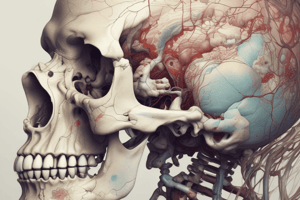Podcast
Questions and Answers
What percentage of the bone matrix is composed of organic matter?
What percentage of the bone matrix is composed of organic matter?
- 20%
- 65%
- 50%
- 35% (correct)
Which type of collagen is found in the organic matter of bone matrix?
Which type of collagen is found in the organic matter of bone matrix?
- Type III collagen
- Type I collagen (correct)
- Type IV collagen
- Type II collagen
What is the primary function of osteoblasts?
What is the primary function of osteoblasts?
- To produce the organic components of the matrix (correct)
- To break down bone matrix
- To form bone marrow
- To maintain bone matrix
What is the name of the calcium-binding protein found in the organic matter of bone matrix?
What is the name of the calcium-binding protein found in the organic matter of bone matrix?
Where are osteocytes located in bone tissue?
Where are osteocytes located in bone tissue?
What is the origin of osteoclasts?
What is the origin of osteoclasts?
What is the function of periosteum and endosteum in bones?
What is the function of periosteum and endosteum in bones?
What is the structure of periosteum?
What is the structure of periosteum?
What is the main characteristic of cancellous bone?
What is the main characteristic of cancellous bone?
What is the arrangement of collagen fibers in lamellar bone?
What is the arrangement of collagen fibers in lamellar bone?
What is an osteon?
What is an osteon?
What is the function of the central canal in an osteon?
What is the function of the central canal in an osteon?
How many kinds of bone lamellae are there in compact bone?
How many kinds of bone lamellae are there in compact bone?
What is the characteristic of circumferential lamellae?
What is the characteristic of circumferential lamellae?
Flashcards are hidden until you start studying
Study Notes
Osseous Tissue
- A specialized connective tissue composed of cells and bone matrix (calcified extracellular material)
Bone Matrix
- Composed of 35% organic matter and 65% inorganic matter
- Inorganic matter: hydroxyapatite crystal, calcium hydroxyapatite, bicarbonate, citrate, magnesium, potassium, and sodium ions
- Organic matter: osteoid (non-calcified bone matrix) consisting of type I collagen, ground substance (GAGs, proteoglycans, and glycoproteins), osteocalcin, osteonectin, and osteopontin
Osteoblast
- Location: on the surface of bone matrix
- Structure: single layer of cuboidal cells
- Outcome: osteocytes and bone lining cells
- Function: produce organic components of the matrix (osteoid) and help with deposition of inorganic components
Osteocyte
- Structure: long thin processes, located in bone lacuna and bone canaliculus
- Function: maintain bone matrix
Osteoclast
- Location: resorption lacunae (or Howship lacunae)
- Structure: multinuclear large cell, 30-100µm, acidophilic cytoplasm
- Origin: fusion of bone marrow-derived monocytes
- Function: dissolve bone matrix
Periosteum and Endosteum
- Periosteum: outer layer and inner layer on the external surface of bone
- Endosteum: delicate matrix of collagen fibers on the internal surface of cavities
Bone Types
- Gross observation: compact bone and cancellous bone
- Under microscope: both show same basic histological structure (lamellar bone)
Lamellar Bone
- Matrix existing as discrete sheets
- Collagen fibers arranged in lamellae
- Typical organization:
- Osteon (Haversian system)
- Interstitial lamellae
- Circumferential lamellae
Osteon (Haversian System)
- Long, cylindrical structure parallel to the long axis of the bone
- 4-20 Haversian lamellae around a central canal
- Outer boundary: the cement line wraps
- Communicated by transverse or oblique Volkmann’s canal
Interstitial Lamellae
- Among the intact osteons
- Irregular lamellae
- Remaining lamellae of osteons
Studying That Suits You
Use AI to generate personalized quizzes and flashcards to suit your learning preferences.



